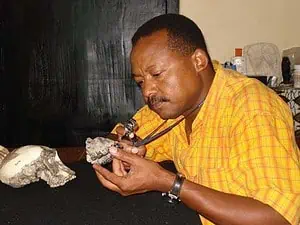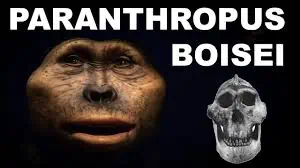OH 89 collar bone discovery announced by Olduvai Gorge archaeological team
In 2005, a team of scientists with the Olduvai Gorge Conservation Project (OCV) discovered two hominin clavicles. The discovery was made just above the surface, “near the FLK North locality, eroding from upper Bed 1, just below tuff 1…” (ref. biorxv.org). The first clavicle OH 48, dated 1.83 million years ago (mya) is undetermined. But researchers recently completed an extensive, and relatively conclusive study of OH 89.
Most Americans are familiar with the clavicle, which is a common bone fractured in football injuries.
Quick reference from Britannica:
 clavicle, also called collarbone, curved anterior bone of the shoulder (pectoral) girdle in vertebrates; it functions as a strut to support the shoulder.
clavicle, also called collarbone, curved anterior bone of the shoulder (pectoral) girdle in vertebrates; it functions as a strut to support the shoulder.
The clavicle is a common site of fracture, particularly at the midsection of the bone; horizontal impact to the shoulder, such as from a fall or trauma, is a common cause.
The research team analyzing the clavicle is led by world-renowned archaeological professor Fidelis Taliwawa Masao of the University of Dar es Salaam. Other members of the team include Agustino Venance Songita, also of the Univ. of Dar es Salaam, Catherine E. Taylor PhD of the University of California at Berkeley and paleoanthropologist Jackson N Njau, (photo) principal curator at the Museum of National Natural History in Arusha, Tanzania.
From the paper at Biorxiv, Feb. 3,
OH 89: A newly described ~1.8-million-year-old hominid clavicle from Olduvai Gorge
 In summary, our analyses demonstrate that OH 89 is, for the most part, on the edge of the range of variation of human clavicular variation despite its antiquity. Although researchers occasionally assign fragmentary, isolated postcrania to species, such a taxonomic identification is not possible for OH 89.
In summary, our analyses demonstrate that OH 89 is, for the most part, on the edge of the range of variation of human clavicular variation despite its antiquity. Although researchers occasionally assign fragmentary, isolated postcrania to species, such a taxonomic identification is not possible for OH 89.
Based on other fossil evidence, we know that around ~1.8 Ma, there were at least two distinct species of hominids living around Olduvai Gorge (Blumenschine et al., 2012; Clarke, 2012; Domínguez-Rodrigo et al., 2015). While it is impossible to decisively say what species OH 89 and OH 48 belonged to, or if they are even conspecific, the discovery of OH 89 does reveal that hominid clavicles show notable similarities to modern humans at least as far back as 1.8 Ma.
The two hominin species alluded too, but not specifically mentioned by the paper’s authors are of course, Homo habilis and Paranthropus Bosiei.
Background: Around 4 to 6 million years ago, the earth’s climate began to shift. The landscape in Africa, particularly northern Africa was greatly affected. What were formerly deep tropical forests became grasslands with sparse forested pockets. Early hominin species such as Ardipithecus ramidus co-discovered by Tim White of UC-Berkeley, evolved into Australopithecines. The Australopiths were better adapted to the new environment. One branch of Australopithecines developed a diet of tubers and other vegetation that required larger chewing muscles and back teeth. They became the Paranthropus line, including the famous Paranthropus Bosiei discovered by Mary Leakey in 1959 nicknamed “Zinj.”
Note – Paranthropus Boisei was named after the philanthropist and British diamond miner Charles Boisei who funded Louis and Mary Leakey’s expeditions,
Could be Paranthropus Boisei, but study authors hint strongly it’s Homo habilis
From Smithsonian:
 Like other members of the Paranthropus genus, P. boiseiis characterized by a specialized skull with adaptations for heavy chewing. A strong sagittal crest on the midline of the top of the skull anchored the temporalis muscles (large chewing muscles) from the top and side of the braincase to the lower jaw, and thus moved the massive jaw up and down. The force was focused on the large cheek teeth (molars and premolars)…
Like other members of the Paranthropus genus, P. boiseiis characterized by a specialized skull with adaptations for heavy chewing. A strong sagittal crest on the midline of the top of the skull anchored the temporalis muscles (large chewing muscles) from the top and side of the braincase to the lower jaw, and thus moved the massive jaw up and down. The force was focused on the large cheek teeth (molars and premolars)…
[With] Mary Leakey’s 1959 discovery of the ‘Zinj’ skull (OH 5) that scientists knew what they had found was a new species. ‘Zinj’ became the type specimen for P. boisei and, soon after, arguably the most famous early human fossil from Olduvai Gorge in northern Tanzania.
The other branch of Australopithecines evolved into the famous Lucy, Australopithecus afarensis, as well as Australopithecus africanus, and later Australopithecus sediba. One of lines of Australopithecines, very possibly A-Sediba, evolved into the first species of genus Homo – Homo habilis, the handy man.
From PBS.org:
 Homo habilis, “handy man,” is so called because of the wealth of tools that have been found with its fossils. The average H. habilis brain was considerably larger than the average Australopithecus brain. The brain shape is also more humanlike. The bulge of Broca’s area, essential for speech, is visible in one H. habilis brain cast, indicating that the species may have been capable of rudimentary speech. The average H. habilis individual is thought to have been about five feet tall and 100 pounds, although females may have been smaller.
Homo habilis, “handy man,” is so called because of the wealth of tools that have been found with its fossils. The average H. habilis brain was considerably larger than the average Australopithecus brain. The brain shape is also more humanlike. The bulge of Broca’s area, essential for speech, is visible in one H. habilis brain cast, indicating that the species may have been capable of rudimentary speech. The average H. habilis individual is thought to have been about five feet tall and 100 pounds, although females may have been smaller.
Very few skeletal fossils have been recovered for Homo habilis. Though, fortunately two fragmented skulls have been found, and a number of teeth. One of the Habilis skulls was of course, the famous OH 7 was discovered by Jonathan, son of Mary and Louis Leakey. The second, OH 62, skull fragments and parts of the hand, were discovered by the Tim White team, led by Donald Johanson in 1986.
(Note – OH is the abbreviation for Olduvai Hominin. Olduvai Gorge shown in the photo).
The paper’s authors are cautious, not explicitly identifying OH 89 as Homo habilis. But the implication is strong.
OH 89, a 1.8 Ma hominid clavicle, falls within the range of modern humans in absolute size and clavicular curvature. This finding indicates that there has been little morphological change in the hominid clavicle in the last ~2 million years.
“Within the range of modern humans,” would indicate not Paranthropus Bosei, but rather genus Homo. As the authors note, that would strongly suggest, that the shoulder and collar bones of modern humans were already set as of 1.8 million years ago.
For a good short intro to Homo habilis, Habella at YouTube. H/t for cover photo.



It looks to me like the release of this paper is a giant nothingburger.
OH89 is a disembodied clavicle of unknown hominid association. They say it has some Homo features to it.
But as far as I know, there are no identified clavicles for either Homo habilis or “Paranthropus” boisei.
So what orifice did they pull this claim from?
For me, this smacks of just more zaniness from the swirlie of Olduvai Gorge.
As a kid I remember reading about Louis Leakey’s find of Zinjanthropus boisei in National Geographic with all the lofty claims of its human lineage. Louie was good at that. Then it became Paranthropus boisei then it became Australopithecus boisei, now it’s Paranthropus boisei again.
For the longest time, more than all through the 70s, Australopithecus boisei was thought to be in the same lineage with Australopithecus robustus. Both featured huge teeth, monster jaw and chewing muscles with sagittal crest.
And for a very long time Australopithecus robustus was thought to be either a contemporary or a sexual dimorph of the more gracile Australopithecus africanus.
But alas, these days Australopithecus robustus has become Paranthropus robustus and now joins Paranthropus boisei as an orphan far from the Homo tree. In the 80s Tim White claimed to have found their apparent ancestor, another sagittal crest vegetarian guy, Paranthropus aethiopicus.
So what I’m trying to say: This region, this era, has been a hot paleo mess. Now we have another unanchored claim over an unidentified collar bone associated with no known fossil hominids.
Might be! Could be! Should be! Would be! ZZZzzzzzzz
It’s important, because this cements Homo habilis as the first in the line of genus Homo. Homo habilis has been sort of a waste basket for hominin bones. Not sure what it is? Just throw it in the Homo habilis taxon. This find firms Homo habilis up. Not entirely. But it helps.
I had some barbecue the other night that had a sneaky resemblance to that clavicle.
Trying to put hominin fossils into the Homo genus makes my head hurt. The definition of human changes by the decade by the person and by the study.
Back in the early 60s, Homo sapiens was supposed to be the exclusive “maker of tools” on the planet. So when Louis Leakey found some bones and associated tools he attributed to Homo habilis, voila by deduction you have a direct ancestor of mankind, right?
But knowledge marches on. We now know chimps use twigs for termites and spears to hunt monkeys. Orangutans fish. Birds of all kinds use rocks to make their meals. Octopi are more tool-adept than your average trailer park resident.
Homo habilis, broadly estimated to have lived from 1.4 to 2.4 million years ago has now been supplanted by a predecessor hominid toolmaker from 3.3 million years ago: https://www.nature.com/articles/nature14464 .
Not to denigrate Leakey’s Homo habilis find, it was and is astounding. But it opens up a universe of questions with few solid answers.
Hey we’re all friends here, right? I’ll go out on a limb.
My suspicion is that Homo habilis may have been the first or one of the first of several long-distance hominid migration pulses out of Africa (maybe into Africa). (Homo erectus certainly being another.)
Based on morphological data, there is reason to believe Homo floresiensis may be close kin to Homo habilis — besides reduced size, in a number of ways it seems a closer fit than Homo erectus. https://www.nature.com/scitable/knowledge/library/homo-floresiensis-making-sense-of-the-small-91387735/
Flores is a long long way from the mainland. And then there is Homo luzonensis, what seems to be a similar hominid situation in the Philipines. Remember, the Philipines has been deep water isolated from the mainland during all of hominid existence.
So . . . If Homo habilis radiated from Africa (or even to Africa) it could be a seafaring hominin of multi-continental prowess.
And you thought Christopher Columbus was ugly. . . .
Duncan, your hypothesis is largely proven to be correct by the Homo habilis/Homo erectus finds at Dminisi. Homo habilis or early Homo erectus left African 1.9 million years ago, as evidenced by that recent tooth found near the Dmanisi site.
I know it doesn’t seem like much of an astounding hypothesis these days. I just felt compelled to say it again because I’ve entertained it for more than 25 years. For me, floresiensis confirmed that habilis radiance was correct and luzonensis reinforced that.
But there was more to my theory. Don’t ask me to prove it but I suspect that habilis was the first hominid wave, outcompeted clean off the continent up out and north by African Homo erectus. I think Luzonensis and floresiensis are evolved habilis pushed to the farthest habitable corners of their earth.
In my imagined narrative, erectus and habilis-plus would have reached a kind of territorial equilibrium of long-standing, with habilis-plus relegated to the hinterlands. But when denisovans and sapiens made later incursions into those regions both erectus and habilis-plus became extinct one pocket at a time. And when sapiens encountered denisovans. . . .
“Just because something is plausible and feasible that doesn’t mean it’s true.”